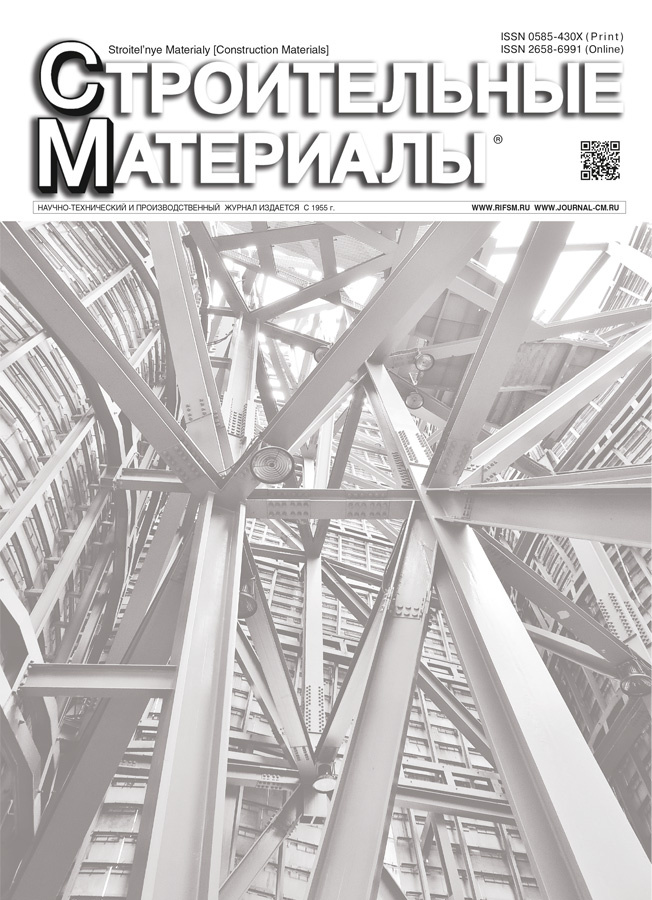Dry Mixtures Strength and Elastic-Deformative Characteristics Determination for Construction 3D Gypsum and Cement Printing
- 作者: Sinitsin D.A.1, Mukhametrakhimov R.K.2, Khafizov A.A.1, Shagigalin G.Y.1, Kuznetsov D.V.1, Nedoseko I.V.1
-
隶属关系:
- Ufa State Petroleum Technological University
- Kazan State University of Architecture and Civil Engineering
- 期: 编号 8 (2025)
- 页面: 9-13
- 栏目: Статьи
- URL: https://gynecology.orscience.ru/0585-430X/article/view/690192
- DOI: https://doi.org/10.31659/0585-430X-2025-838-8-9-13
- ID: 690192
如何引用文章
详细
A new technique for dry mixtures strength and elastic-deformative characteristics determination for construction 3D gypsum, cement and mixed printing is described. It is shown that the standard testing methods of concretes and mortars used in construction practice for fine-grained concretes and mortars are inapplicable: firstly, due to the scale factor, and secondly, due to the significant voidness of the printed samples, which also varies widely. The developed technique is based on the method for determining the grouting mixtures characteristics on small cross-section samples. A new formwork mold consisting of several cylindrical links (in metal or polymer), allowing the samples molding and subsequent exposure directly during 3D printing, has been developed and tested in pilot industrial conditions. The samples made according to the proposed method were tested on a universal testing machine and their results made it possible to determine with sufficient reliability the dry mixes basic strength and elastic-deformative characteristics for construction 3D printing, such as compressive strength, prism strength, elasticity modulus, transverse deformation coefficient and to construct a full-scale stress–relative deformation curve.
全文:
作者简介
D. Sinitsin
Ufa State Petroleum Technological University
编辑信件的主要联系方式.
Email: d4013438@yandex.ru
Candidate of Sciences (Engineering), Associate Professor
俄罗斯联邦, 195, Mendeleev St., Ufa, 450062R. Mukhametrakhimov
Kazan State University of Architecture and Civil Engineering
Email: muhametrahimov@mail.ru
Doctor of Sciences (Engineering), Associate Professor
俄罗斯联邦, 1, Zelenaya St., Kazan, 420043A. Khafizov
Ufa State Petroleum Technological University
Email: maksim0_0_0@mail.ru
Engineer, Postgraduate Student
俄罗斯联邦, 195, Mendeleev St., Ufa, 450062G. Shagigalin
Ufa State Petroleum Technological University
Email: ufa-gazinur@mail.ru
Engineer, Postgraduate Student
俄罗斯联邦, 195, Mendeleev St., Ufa, 450062D. Kuznetsov
Ufa State Petroleum Technological University
Email: alex.03_2017@mail.ru
Candidate of Sciences (Engineering), Associate Professor
俄罗斯联邦, 195, Mendeleev St., Ufa, 450062I. Nedoseko
Ufa State Petroleum Technological University
Email: nedoseko1964@mail.ru
Doctor of Sciences (Engineering), Professor
俄罗斯联邦, 195, Mendeleev St., Ufa, 450062参考
- Mukhametrahimov R.Kh., Ziganshina L.V. Technology and quality control of construction 3D printing. Izvestiya of the Kazan State University of Architecture and Civil Engineering. 2022. No. 1 (59), pp. 64–79. (In Russian). EDN: BZJGUO. https://doi.org/10.52409/20731523_2022_1_64
- Klyuev S.V., Klyuev A.V., Shorstova E.S., Vatin N.I. Technology of 3-d printing of fiber reinforced mixtures. Sustainable Energy Systems: Innovative Perspectives: Conference proceedings. Saint Petersburg. 2021, pp. 224–230. EDN: DZNVBD. https://doi.org/10.1007/978-3-030-67654-4_25
- Mukhametrakhimov R.Kh., Galautdinov A.R., Ziganshina L.V. Modified fine-grained cement concretes for additive construction production. Izvestiya of Higher Educational Institutions. Construction. 2024. No. 5 (785), pp. 77–93. (In Russian). EDN: FOCQVS. https://doi.org/10.32683/0536-1052-2024-785-5-77-93
- Ryazanov A.N., Shigapov R.I., Sinitsin D.A., Kinzyabulatova D.F., Nedoseko I.V. The use of gypsum compositions in the technologies of construction 3D printing of low-rise residential buildings. Problems and prospects. Stroitel’nye Materialy [Construction Materials]. 2021. No. 8, pp. 39–44. (In Russian). EDN: NNRNHD. https://doi.org/10.31659/0585-430X-2021-794-8-39-44
- Mukhametrakhimov R.Kh., Garafiev A.M., Aleksandrova O.V., Bulgakov B.I. Structure and properties of modified shungite concrete during electrode heating. Construction Materials and Products. 2023. Vol. 6, No. 6. EDN: BJXLNE. https://doi.org/10.58224/2618-7183-2023-6-6-1
- Rakhimov R.Z., Mukhametrakhimov R.Kh., Galautdinov A.R., Ziganshina L.V. Gypsum-cement-pozzolanic concretes for additive construction production. Vestnik MGSU. 2024. Vol. 19. No. 4, pp. 580–595. (In Russian). EDN: DZSMZH. https://doi.org/10.22227/1997-0935.2024.4.580-595
- Mukhametrahimov R.Kh., Kayumov R.A. Optimization of additive construction production by modeling the stress-strain state of printed layers. Izvestiya of Higher Educational Institutions. Construction. 2024. No. 7 (787), pp. 104–119. (In Russian). EDN: SKAHQA. https://doi.org/10.32683/0536-1052-2024-787-7-104-119
- Adamtsevich A.O., Pustovgar A.P., Adamtsevich L.A. Additive construction production: features of technology application. Promyshlennoye i Grazhdanskoye Stroitel’stvo. 2023. No. 7, pp. 70–78. (In Russian). EDN: VMSBNF. https://doi.org/10.33622/0869-7019.2023.07.70-78
- Kuznetsov D.V., Kluev S.V., Ryazanov A.N. at all. Dry mixes on gypsum and mixed bases in the construction of low-residential buildings using 3D-printing technology. Construction Materials and Products. 2023. Vol. 6. No. 6. EDN: TBRUNZ. https://doi.org/10.58224/2618-7183-2023-6-6-5
- Mukhametrahimov R.Kh., Galautdinov A.R., Ziganshina L.V. Improving additive construction production by increasing the adhesion of layers during long breaks in the 3D printing process. Izvestiya of the Kazan State University of Architecture and Civil Engineering. 2024. No. 1 (67), pp. 127–134. (In Russian). EDN: ULXEQB. https://doi.org/10.48612/NewsKSUAE/67.13
- Mukhametrahimov R.Kh. Study of plasticizing additives based on polycarboxylate esters on the properties of concrete formed by 3D printing. Construction Materials and Products. 2022. Vol. 5. No. 5, pp. 42–58. (In Russian). EDN CLDKGL. https://doi.org/10.58224/2618-7183-2022-5-5-42-58
- Kumar L.J., Krishnadas Nair C.G. Current Trends of Additive Manufacturing in the Aerospace Industry. In: Wimpenny D., Pandey P., Kumar L. (eds). Advances in 3D printing & additive manufacturing technologies. Springer, Singapore. 2017. https://doi.org/10.1007/978-981-10-0812-2_4
- Akulova I.I., Slavcheva G.S., Makarova T.V. Technical and economic estimate of efficiency of using 3D printing in housing construction. Zhilishchnoe Stroitel’stvo [Housing Construction]. 2019. No. 12, pp. 52–56. (In Russian). EDN: PPGWSW. https://doi.org/10.31659/0044-4472-2019-12-52-56
- Slavcheva G.S. 3D-build printing today: potential, challenges and prospects for implementation. Stroitel’nye Materialy [Construction Materials]. 2021. No. 5, pp. 28–36. (In Russian). EDN: WACJMY. https://doi.org/10.31659/0585-430X-2021-791-5-28-36
- Shigapov R.I., Shagigalin G.Yu., Klyuev A.V., et al. Evaluation of the durability of dry mix compositions based on gypsum and gypsum cement for 3D printing. Stroitel’nye Materialy [Construction Materials]. 2024. No. 7, pp. 26–32. (In Russian). EDN: SIEBIC. https://doi.org/10.31659/0585-430X-2024-826-7-26-32
补充文件











